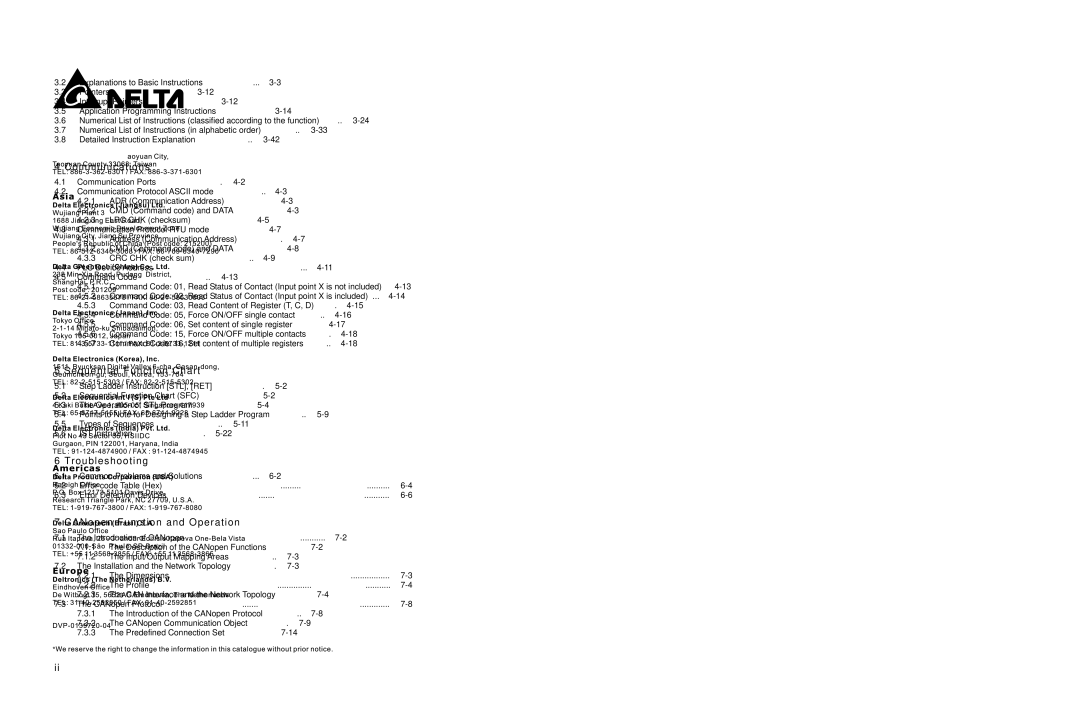3.2Explanations to Basic Instructions…………………………………………………………...
3.3Pointers…………………………………………………………………………………………
3.4Interrupt Pointers………………………………………………………………………………
3.5 Application Programming Instructions………………………………………………………
3.6Numerical List of Instructions (classified according to the function)……………………..
3.7Numerical List of Instructions (in alphabetic order)………………………………………..
3.8Detailed Instruction Explanation……………………………………………………………..
4 Communications
4.1Communication Ports………………………………………………………………………….
4.2Communication Protocol ASCII mode………………………………………………………..
4.2.1 ADR (Communication Address) …………………………………………………… | ||
4.2.2 | CMD (Command code) and DATA………………………………………………… | |
4.2.3 | LRC CHK (checksum) ……………………………………………………………… | |
4.3 Communication Protocol RTU mode………………………………………………………… | ||
4.3.1Address (Communication Address) ……………………………………………….
4.3.2 CMD (Command code) and DATA…………………………………………………
4.3.3 CRC CHK (check sum) ……………………………………………………………..
4.4PLC Device Address…………………………………………………………………………...
4.5Command Code………………………………………………………………………………..
4.5.1 Command Code: 01, Read Status of Contact (Input point X is not included)…
4.5.2Command Code: 02, Read Status of Contact (Input point X is included)……...
4.5.3Command Code: 03, Read Content of Register (T, C, D)……………………….
4.5.4Command Code: 05, Force ON/OFF single contact……………………………..
4.5.5 Command Code: 06, Set content of single register………………………………
4.5.6Command Code: 15, Force ON/OFF multiple contacts………………………….
4.5.7Command Code: 16, Set content of multiple registers…………………………..
5 Sequential Function Chart
5.1Step Ladder Instruction [STL], [RET] ……………………………………………………….
5.2 | Sequential Function Chart (SFC) …………………………………………………………… | |
5.3 | The Operation of STL Program……………………………………………………………… |
5.4Points to Note for Designing a Step Ladder Program……………………………………..
5.5Types of Sequences…………………………………………………………………………..
5.6IST Instruction………………………………………………………………………………….
6 Troubleshooting
6.1Common Problems and Solutions…………………………………………………………...
6.2Error code Table (Hex) …………………………………………………………...................
6.3Error Detection Devices…………………………………………………………..................
7 CANopen Function and Operation
7.1The Introduction of CANopen…………………………………………………………...........
7.1.1 The Description of the CANopen Functions………………………………………
7.1.2The Input/Output Mapping Areas…………………………………………………..
7.2The Installation and the Network Topology………………………………………………….
7.2.1The Dimensions………………………………………………………….................
7.2.2The Profile…………………………………………………………..........................
7.2.3 The CAN Interface and the Network Topology……………………………………
7.3The CANopen Protocol…………………………………………………………....................
7.3.1The Introduction of the CANopen Protocol………………………………………..
7.3.2The CANopen Communication Object…………………………………………….
7.3.3 The Predefined Connection Set……………………………………………………
i i
